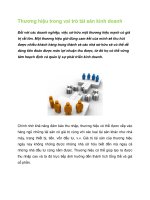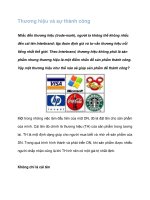Tài liệu thương hiệu B2C phần 3 docx
Bạn đang xem bản rút gọn của tài liệu. Xem và tải ngay bản đầy đủ của tài liệu tại đây (118.37 KB, 5 trang )
Being Known or Being One of Many 11
dynamic. Brand management is challenging – whether you are in
the consumer goods, services or industrial products sectors. There-
fore, we will provide you with insights about actual brand rele-
vance in your area.
Branding Dimensions – Since nothing can be done without know-
ing the fundamentals, this stage is to give you an understanding of
the general branding dimensions especially aligned to cover the
B2B area. Furthermore, we will point out factors that are necessary
to accelerate the success of a company through branding efforts. As
a foundation, you need to know the basics and understand what a
holistic branding approach can accomplish if soundly realized.
Acceleration Through Branding – This is finally the “How to do it”
chapter in this book. Here you will learn how to plan, create, im-
plement, and manage your brand strategy. Moreover you will find
examples of the first branding steps of other companies.
Success Stories – No book on branding is without success stories
neither is this one. Without the living proof that branding efforts in
B2B can be successful some business companies would probably
never think of creating brands themselves. In this chapter we will
provide you with some insights into strongly branded B2B compa-
nies from various industries. Although no company can be success-
ful by imitating the brand management of another business it can
gain valuable information and hints for their own brand. Important
questions related to the point of differentiation, factors of success,
and even similarities can be answered.
Branding Pitfalls – Branding in general is a delicate matter. Brand-
ing in B2B can be even more delicate if one doesn’t understand
what it is all about. There are some general pitfalls generated by
common misunderstandings related to branding. We deliberately
dedicated a whole chapter to branding pitfalls in order to demon-
strate the importance of taking careful and well considered actions
related to brand management. Brands are just as fragile as they are
profitable if well managed.
12 Being Known or Being One of Many
Future Perspective – In this chapter we will try to provide you with
some outlook into the future. We will concentrate on depicting gen-
eral implications rather than making specific predictions of the fu-
ture. Future trends towards Corporate Social Responsibility and
Design emphasis for instance are important developments that can
change and redefine brand management of the future.
The essence of this book is to infect B2B companies with the brand-
ing-virus – empowering them to make the leap to becoming a
brand-driven and more successful company. There are many ways
to measure overall company success: sales increase, share value,
profit, number of employees, mere brand value (index), etc. To keep
it simple and to limit alterations that may have been influenced by
various other sources than the actual brand, we chose sales over
time as measurement for a company’s success in our Guiding Prin-
ciple. The transition point represents a company’s rise to the chal-
lenge of building a B2B brand.
Summary
• Branding is just as relevant in B2B as it is in B2C. Brands like
Microsoft, IBM, Intel, Dell, SAP, Siemens, FedEx, Boeing are vivid
examples of the fact that some of the world’s strongest brands
do exist in B2B.
• Branding is not about stirring people into irrational buying deci-
sions – it is rather an effective and compelling means to com-
municate the benefits and value a product or service can provide.
• Branding is about taking something common and improving
upon it in ways that make it more valuable and meaningful.
• Trusted brands act as touchstones, offering orientation the
flood of information, and many other benefits and advantages
to buyers.
• A brand is much more than a product, a brand name, a logo, a
symbol, a slogan, an ad, a jingle, a spokesperson; these are just
tangible components of a brand – not the brand itself!
Being Known or Being One of Many 13
• “Brand” comprises various aspects. A brand is a promise, the
totality of perceptions – everything you see, hear, read, know,
feel, think, etc. – about a product, service, or business. It holds
a distinctive position in customer’s minds based on past ex-
periences, associations and future expectations. It is a short-cut
of attributes, benefits, beliefs and values that differentiate, re-
duce complexity, and simplify the decision-making process.
• Branding should always start at the top of a business. Build-
ing, championing, supporting and protecting strong brands is
everyone’s job, starting with the CEO.
• Brands do pay off. Companies with a strong brand can benefit
tremendously from it. A vibrant brand and its implicit promise
of quality can provide businesses with the power to command
a premium price among customers and a premium stock price
among investors; it can boost their earnings and cushion cycli-
cal downturns.
• The most important brand functions in B2B are increased in-
formation efficiency, risk reduction and value added/image
benefit creation.
Notes
1
David A. Aaker and Erich Joachimsthaler, Brand Leadership, 2000, p. 22;
Mia Pandey, “Is Branding Relevant to B2B?,” brandchannel.com (27 Janu-
ary 2003).
2
As quoted in Gerry Khermouch, Stanley Holmes and Moon Ihlwan,
“The Best Global Brands,” Business Week (6 August 2001).
3
Gerry Khermouch, Stanley Holmes and Moon Ihlwan, “The Best Global
Brands,” Business Week (6 August 2001).
4
Web site of The Boeing Company, Chicago, IL, cited August 2005.
5
Paul Hague and Peter Jackson, The Power of Industrial Brands, 1994.
6
Peter de Legge, “The Brand Version 2.0: Business-to-Business Brands in
the Internet Age,” Marketing Today, 2002.
7
Scott Bedbury, A New Brand World, 2002, p. 14.
14 Being Known or Being One of Many
8
James C. Anderson and James A. Narus, Business Market Management:
Understanding, Creating, and Delivering Value, p. 136.
9
Dan Morrison, “The Six Biggest Pitfalls in B-to-B Branding,” Busi-
ness2Business Marketer (July/August, 2001): p. 1.
10
Tom Blackett, Trademarks, 1998.
11
Jim Collins, Good to Great. Why Some Companies Make the Leap and Others
Don’t, 2001.
12
Gerry Khermouch, Stanley Holmes and Moon Ihlwan, “The Best Global
Brands,” Business Week (6 August 2001).
13
Mia Pandey, “Is Branding Relevant to B2B?,” brandchannel.com (27 Janu-
ary 2003).
14
Michael Dunn, Scott M. Davis, “Creating the Brand-Driven Business:
It’s the CEO Who Must Lead the Way,” in Handbook of Business Strategy
(Vol. 5 No. 1, 2004), pp. 241-245; Duane E. Knapp, The Brand Mindset,
2000, p. 7.
15
David A. Aaker and Erich Joachimsthaler, Brand Leadership, 2000, p. 8.
16
Scott Bedbury, A New Brand World, 2002, p. Intro.
17
David A. Aaker and Erich Joachimsthaler, Brand Leadership, 2000, p. 9.
18
Source: BBDO Consulting Analysis 2005 – reprinted with permission.
19
Gerry Khermouch, Stanley Holmes and Moon Ihlwan, “The Best Global
Brands,” Business Week (6 August 2001).
20
Rita Clifton and John Simmons, Brands and Branding, 2003, p. 5.
21
Mirko Caspar, Achim Hecker, and Tatjana Sabel, “Markenrelevanz in
der Unternehmensfuehrung – Messung, Erklaerung und empirische
Befunde fuer B2B-Maerkte,” 2002, p. 13.
22
Ibid.
23
We understand the Guiding Principle as the leading idea and guiding
help to follow our thinking and the structure of the chapters.
/>









